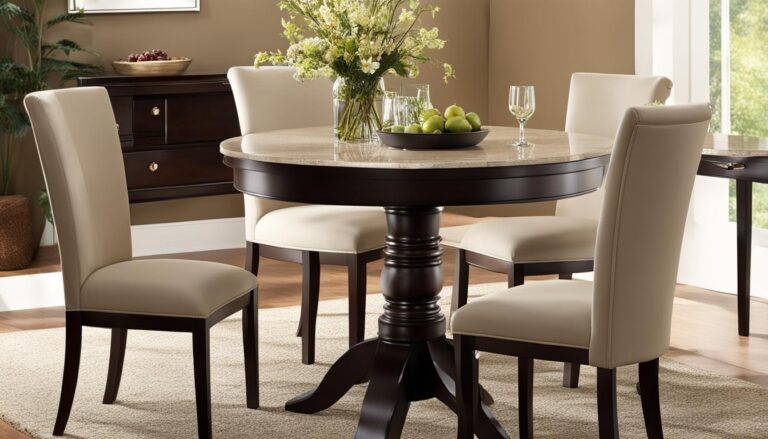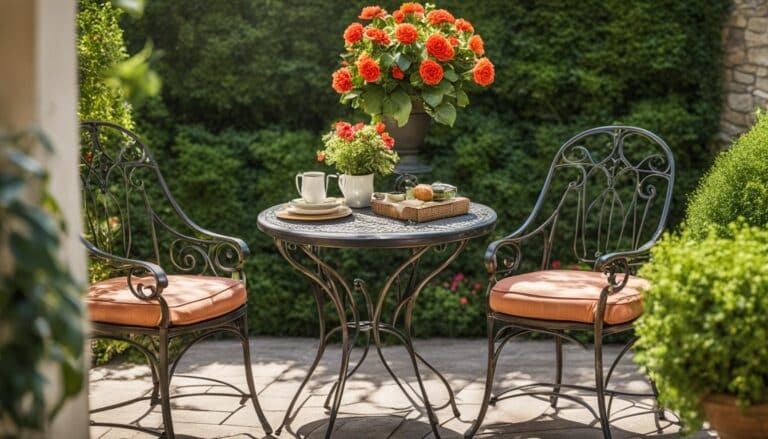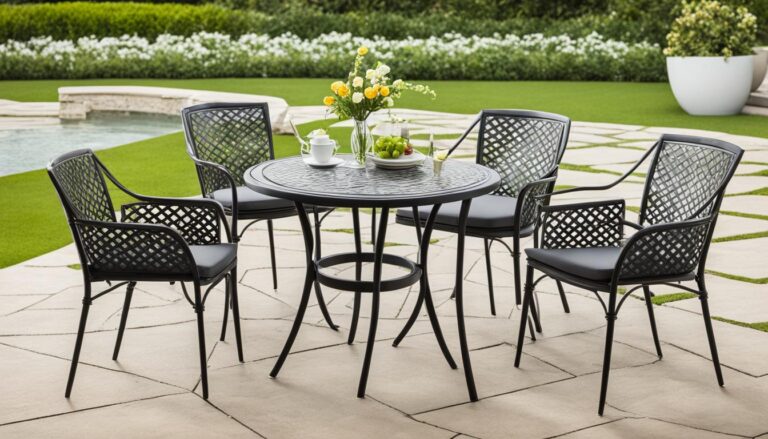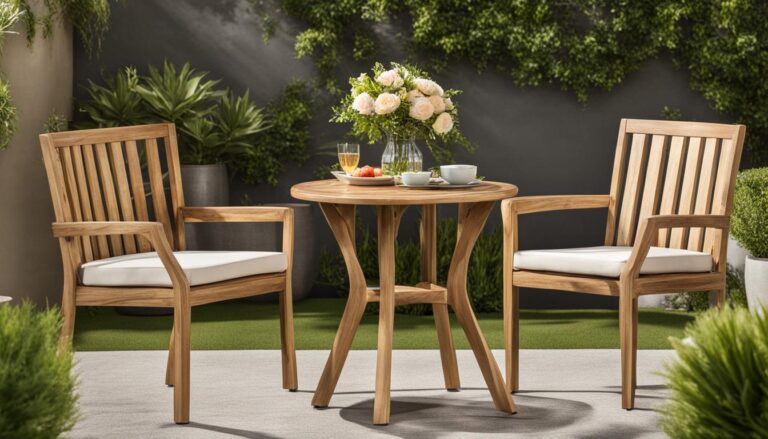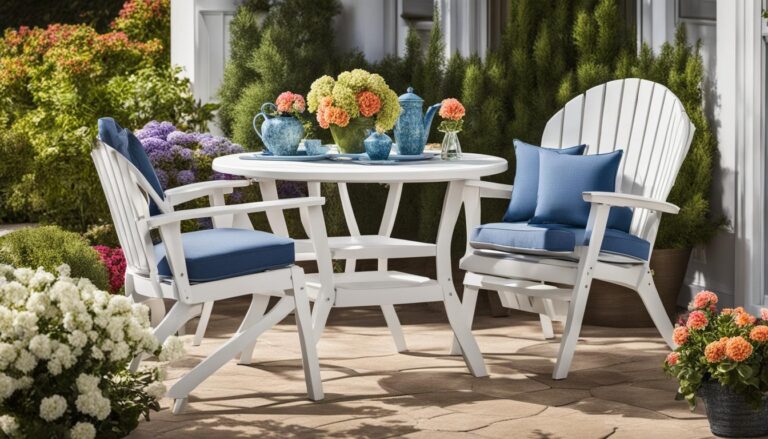To protect your patio furniture from wind damage, it’s important to take the right measures. The last thing you want is to see your precious furniture blown away by strong gusts. By following these tips, you can ensure that your outdoor oasis remains safe and intact even during the windiest days.
Key Takeaways:
- Choose heavy furniture materials like wood, wrought iron, cast aluminum, or steel for better wind resistance.
- Create a windbreak by planting shrubs or trees near your patio to reduce the force of the wind.
- Use a weighted umbrella base to anchor your umbrella and prevent it from being carried away.
- Stack lightweight chairs and store them in a corner when not in use to prevent them from blowing away.
- Apply earthquake gel to the bottom of table and chair legs to keep them from slipping in strong winds.
Invest in Heavy Furniture
When it comes to securing your patio furniture from strong winds, investing in heavy furniture is a smart choice. Opt for materials like wood, wrought iron, cast aluminum, or steel, as these are heavier and less likely to be moved by gusts of wind. These sturdy materials provide stability and can withstand the force of strong winds, ensuring that your outdoor furniture stays in place.
Not only do heavy furniture materials resist wind better, but they also offer durability and longevity. They are less likely to warp, crack, or break under extreme weather conditions, making them a great investment for your outdoor space. With heavy furniture, you can enjoy peace of mind knowing that your patio set will remain secure even during windy weather.
| Material | Wind Resistance |
|---|---|
| Wood | Good |
| Wrought Iron | Excellent |
| Cast Aluminum | Very Good |
| Steel | Excellent |
Investing in Heavy Furniture
Investing in heavy furniture is a wise decision for those looking to secure their patio furniture from wind damage. The table above provides a quick overview of the wind resistance of different materials commonly used in outdoor furniture. Choose a material that suits your style and budget, while also considering its ability to withstand strong winds.
In addition to material choice, consider the overall design and construction of the furniture. Look for pieces with sturdy frames and reinforced joints for added stability. Keep in mind that heavier furniture may be more challenging to move around, so it’s essential to plan the layout of your outdoor space accordingly. By investing in heavy furniture, you can enjoy your patio without worrying about wind-induced furniture displacement.
Plant a Windbreak
To protect your patio furniture from strong winds, consider creating a natural barrier by planting a windbreak. A windbreak consists of thick shrubs or trees strategically placed near your patio to block and reduce the force of the wind. This not only helps to keep your furniture secure but also enhances the overall aesthetics of your outdoor space.
Landscaping Ideas for Wind Protection
When selecting plants for your windbreak, opt for species that are known for their ability to withstand strong winds. Evergreen trees such as arborvitae, spruce, and pine are great choices, as they provide year-round protection. Additionally, deciduous trees like oak, maple, and beech can also serve as effective windbreaks during the warmer months when their leaves are in full bloom.
Position the windbreak strategically to maximize its effectiveness. Plant the trees or shrubs on the windward side of your patio, where the prevailing winds come from. This ensures that the wind is intercepted and slowed down before reaching your furniture, minimizing the risk of damage.
| Plant | Height (ft) | Spread (ft) | Wind Tolerance |
|---|---|---|---|
| Arborvitae | 10-30 | 3-20 | High |
| Spruce | 20-60 | 10-35 | High |
| Pine | 40-80 | 15-40 | High |
| Oak | 50-100 | 50-100 | Medium |
| Maple | 40-80 | 40-70 | High |
| Beech | 50-80 | 40-60 | Medium |
By investing in a windbreak through thoughtful landscaping, you can enjoy your outdoor furniture without constantly worrying about wind damage. Create a peaceful and protected oasis where you can relax and entertain, no matter how gusty the weather gets.
Get a Weighted Umbrella Base
When it comes to securing your umbrella in windy conditions, a weighted umbrella base is a must-have accessory. Designed specifically for wind protection, this base will keep your umbrella in place and prevent it from being carried away by strong gusts.
To use a weighted umbrella base, simply place it on the ground and secure your umbrella pole into the center hole. The weight of the base will provide stability and keep your umbrella upright, even during gusty weather. For added security, you can fill the base with water or sand, increasing its weight and resistance to wind.
Weighted umbrella bases come in various sizes and styles to suit different types of umbrellas. Whether you have a traditional patio umbrella or a cantilever umbrella, there’s a weighted base that will fit your needs. Look for bases made from durable materials like plastic, resin, or concrete, as these are designed to withstand outdoor conditions and provide long-lasting support.
| Benefits of a Weighted Umbrella Base |
|---|
| Stability: The weighted base keeps your umbrella firmly in place, preventing it from tipping over or getting blown away. |
| Easy Installation: Simply place the base on the ground and insert your umbrella pole. No complicated assembly or installation required. |
| Portability: Many weighted umbrella bases are designed with handles or wheels, making it easy to move and reposition your umbrella as needed. |
| Versatility: Weighted umbrella bases can be used with a variety of umbrella styles and sizes, ensuring compatibility with your existing outdoor furniture. |
Investing in a weighted umbrella base is a simple yet effective way to secure your umbrella and protect it from wind damage. By keeping your umbrella stable and in place, you can enjoy the shade and shelter it provides without worrying about it being swept away by a strong breeze.
Stack Your Chairs
When it comes to windy weather, stacking your chairs is a simple yet effective way to prevent them from blowing away. Lightweight chairs can easily be picked up and carried by strong gusts, but stacking them consolidates their weight and helps anchor them to the ground. By stacking the chairs and placing them in a corner or against a wall, you create a stable configuration that is less likely to be affected by wind forces.
Not only does this method enhance the stability of your chairs, but it also maximizes the space on your patio when the furniture is not in use. Stacked chairs take up less room and can be easily stored until they are needed again. This is particularly beneficial for smaller outdoor spaces where every inch counts.
When stacking your chairs, make sure to place a protective barrier between them to prevent any scratches or damage. You can use furniture pads or simply fold a towel and place it between each chair. This will help maintain the condition of your chairs and ensure they are ready for use whenever you want to enjoy your outdoor space.
| Pros | Cons |
|---|---|
| Easy and cost-effective | May not work for extremely heavy or bulky chairs |
| Conserves space on your patio | May require additional storage space for stacked chairs |
| Helps prevent chairs from blowing away | Requires manual stacking and unstacking |
Overall, stacking your chairs is a practical way to ensure they remain secure in windy weather. It’s a simple solution that can save you from constantly chasing after runaway chairs and keep your outdoor space organized and functional.
Use Earthquake Gel
Another effective method to prevent your patio furniture from slipping in strong winds is to use earthquake gel. This clear compound provides additional grip and stability, keeping your furniture securely in place. Simply apply the gel to the bottom of your table and chair legs, following the manufacturer’s instructions.
Earthquake gel is specifically designed to absorb vibrations and prevent objects from sliding or tipping over. Its adhesive properties create a strong bond between your furniture and the ground, making it an ideal solution for windy conditions.
With earthquake gel, you can enjoy peace of mind knowing that your patio furniture will remain in place, even during gusty weather. It is a cost-effective and easy-to-use option for enhancing the stability of your outdoor furniture.
Stake & Anchor It
To ensure maximum stability for your patio furniture, especially if it’s placed on grass, consider staking and anchoring it to the ground. This will prevent it from being easily carried away by strong winds. Here are some effective methods:
Using Stakes
If your furniture has legs or supports that can be looped through, use stakes to secure them to the ground. Drive the stakes deep into the ground, ensuring they are firmly planted. Connect the stakes to the furniture using strong, weather-resistant chains or cords. This will create a sturdy anchor and help keep your furniture in place during windy conditions.
Utilizing Chains
If stakes are not suitable for your furniture, you can also use chains to anchor it. Attach one end of a chain to a weighty object such as a concrete block, and the other end to your furniture. Make sure the chain is taut and securely fastened to both the anchor and the furniture. This method provides an additional level of security against wind gusts.
Anchors for Hard Surfaces
If your patio furniture is placed on a hard surface like concrete or decking, using anchor systems specifically designed for these surfaces can provide stability. These anchors can be screwed or bolted into the surface, and the furniture can be connected to them using chains or cords. This ensures that your furniture remains securely in place even during strong winds.
By staking and anchoring your patio furniture, you can enjoy peace of mind knowing that it will stay in place even during windy conditions. Choose the method that works best for your furniture and outdoor space, and ensure that all connections are secure and properly maintained.
| Method | Pros | Cons |
|---|---|---|
| Staking | – Provides stability | – May require drilling or modifying furniture |
| Chains | – Can be used with various furniture types | – Requires sturdy anchor points |
| Hard Surface Anchors | – Designed specifically for concrete or decking | – May leave permanent marks on the surface |
Secure With Bungee Cords
When it comes to securing your patio furniture in windy conditions, bungee cords are a versatile and effective solution. These elastic cords can help keep your furniture bound together, creating a natural anchor and preventing it from being blown away. Here’s how you can use bungee cords to secure your outdoor oasis:
1. Wrap the Cords Around
Start by wrapping the bungee cords tightly around all the pieces of furniture. This will help consolidate the weight and keep the items from being easily moved by strong winds. Make sure to loop the cords through the legs or any sturdy points of your furniture for a secure hold.
2. Tie to a Permanent Structure
In extreme weather conditions, it’s a good idea to take an extra precautionary step and tie the ends of the bungee cords to a permanent structure. This could be a fence, a railing, or any other sturdy fixture in your outdoor space. By anchoring your furniture to a stable object, you can provide added security and minimize the risk of it being carried away.
3. Adjust as Needed
Regularly check the tension of the bungee cords and adjust them if necessary. Over time, the cords may stretch or loosen, so it’s important to ensure they remain tight and secure. By maintaining the proper tension, you can keep your patio furniture well-protected even during unpredictable wind conditions.
By using bungee cords, you can easily safeguard your patio furniture without compromising its aesthetics. These flexible cords provide a practical solution for securing different types of outdoor furniture, from chairs and tables to umbrellas and cushions. Invest in high-quality bungee cords to ensure durability, and enjoy your outdoor space with peace of mind, knowing that your furniture is safe and secure.
| Pros | Cons |
|---|---|
| Easy to use and adjust | May not withstand extremely strong winds |
| Versatile, suitable for various furniture types | Requires regular maintenance and adjustment |
| Provides a natural anchor without compromising aesthetics | Quality of bungee cords may vary, so choose durable options |
Bringing the Furniture Indoors
When the wind picks up, it’s essential to take proactive measures to protect your outdoor furniture from potential damage. One effective solution is to bring your patio furniture indoors when it’s not in use. By doing so, you not only prevent it from blowing away but also prolong its lifespan by shielding it from harsh weather conditions.
Bringing your furniture indoors offers a convenient and practical solution. If you have a spacious garage, basement, or even a man cave, these areas can serve as perfect storage spaces for your patio furniture. Ensure the area is clean and has sufficient room for the furniture to be stored safely. Consider covering the furniture with protective covers or blankets to prevent dust accumulation and scratches during storage.
An alternative option is to repurpose your outdoor furniture for indoor use during the colder months. This allows you to continue enjoying your favorite pieces year-round while keeping them safe from wind damage. Place the furniture strategically in your basement, sunroom, or any other suitable indoor space, and style it to complement your interior decor.
Tips for Bringing Your Patio Furniture Indoors
- Measure the indoor space before bringing the furniture in to ensure it fits comfortably.
- Clean the furniture thoroughly before storage to remove any dirt or debris.
- Disassemble any collapsible or detachable parts, such as umbrella stands or table legs, to save space.
- Use furniture sliders or protective pads to prevent scratching or damaging floors during the moving process.
- Consider using storage covers or blankets to provide an extra layer of protection against dust and potential scratches.
| Advantages of Bringing Furniture Indoors | Disadvantages of Bringing Furniture Indoors |
|---|---|
| Protection from wind damage | Requires adequate indoor storage space |
| Extended furniture lifespan | Additional effort required for moving the furniture |
| Allows year-round use of outdoor furniture | Potential inconvenience of transitioning furniture in and out |
| Opportunity to showcase outdoor furniture indoors | May not be suitable for large or bulky furniture |
By utilizing these tips and bringing your patio furniture indoors, you can proactively protect it from wind damage while enjoying the benefits of a well-maintained outdoor living space. Remember to plan ahead, prepare your furniture for storage, and make the most of indoor spaces to keep your outdoor oasis intact.
Conclusion
Securing your patio furniture from wind damage is essential to maintaining its longevity and preserving your outdoor oasis. By implementing a few simple tips, you can ensure that your furniture remains safe and secure even during strong winds.
Investing in heavy furniture made of materials like wood, wrought iron, cast aluminum, or steel provides a sturdy foundation that is less likely to be moved by strong gusts of wind. Additionally, creating a windbreak by planting thick shrubs or trees near your patio helps block and reduce the force of the wind, further protecting your furniture.
Utilizing weighted umbrella bases, stacking lightweight chairs, applying earthquake gel to table and chair legs, and using stakes or anchors can all contribute to keeping your patio furniture in place during windy conditions. And if the weather becomes too severe, consider bringing your furniture indoors or finding a protected storage area to prevent any potential damage.
By following these patio furniture wind prevention tips, you can rest assured that your outdoor furniture will remain secure and intact, allowing you to enjoy your outdoor space without any worries.
FAQ
How can I secure my patio furniture from wind damage?
There are several measures you can take to protect your patio furniture from wind damage. Here are some tips:
What type of furniture should I choose for better wind resistance?
Opt for heavier materials like wood, wrought iron, cast aluminum, or steel, as these are less likely to be moved by strong winds.
How can I create a windbreak for my patio furniture?
To create a windbreak, plant thick shrubs or trees near your patio. This will help block and reduce the force of the wind, keeping your furniture secure.
How can I prevent my umbrella from being carried away by the wind?
Use a weighted umbrella base specifically designed to anchor the umbrella. Fill the base with water or sand for added stability.
What should I do with lightweight chairs when not in use?
Stack lightweight chairs and store them in a corner. This consolidates the weight and helps anchor the chairs, preventing them from being blown away.
How can I prevent my furniture from moving in strong winds?
Apply earthquake gel to the bottom of table and chair legs. This clear compound provides additional grip and stability.
How can I anchor my furniture to the ground?
If your furniture is on grass, use stakes to anchor it. Loop the stake through the furniture’s legs or use chains to connect the stake to the furniture. For hard surfaces, consider using anchors for stability.
How can I secure my patio furniture together?
Use bungee cords to wrap around all the pieces, keeping them bound together and creating a natural anchor. In extreme weather, tie the ends of the cords to a permanent structure for added security.
Should I bring my patio furniture indoors when not in use?
It’s recommended to bring your patio furniture indoors when not in use. This prevents it from blowing away and extends its lifespan. Alternatively, you can use the furniture in a basement or man cave during the winter months.


